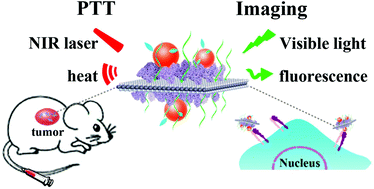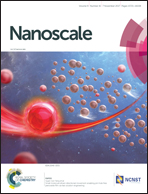RGD-QD-MoS2 nanosheets for targeted fluorescent imaging and photothermal therapy of cancer†
Abstract
The fast-developing field of nanotechnology provides unprecedented opportunities for the increasing demands of biomedicine, especially for cancer diagnostics and treatment. Here, novel multifunctional zero-dimensional-two-dimensional (0D–2D) RGD-QD-MoS2 nanosheets (NSs) with excellent fluorescence, photothermal conversion, and cancer-targeting properties were successfully prepared by functionalizing single-layer MoS2 NSs with fluorescent quantum dots (QDs) and arginine–glycine–aspartic (RGD) containing peptides. By using RGD-QD-MoS2 NSs as a multifunctional theranostic agent, targeted fluorescent imaging and photothermal therapy (PTT) of human cervical carcinoma (HeLa) cells were achieved. Moreover, HeLa tumors in mouse models can be fluorescently imaged and completely eradicated by photothermal irradiation using a low power NIR laser, due to the effective accumulation of RGD-QD-MoS2 NSs at the tumor sites through the RGD-integrin targeting and the enhanced penetration and retention (EPR) effect. Without exhibiting any appreciable toxicity to treated cells or animals, RGD-QD-MoS2 NSs have been demonstrated as promising multifunctional theranostic agents for cancer imaging and therapy.



 Please wait while we load your content...
Please wait while we load your content...